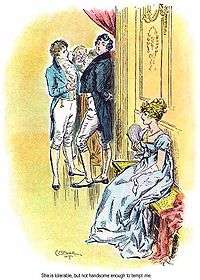Eligible bachelor
An eligible bachelor is a bachelor considered to be a particularly desirable potential husband, usually due to wealth, social status or other specific personal qualities.

In the United Kingdom, the heir to the throne or someone close in succession is often considered to be the nation's, or the world's most eligible bachelor, due to their social status, as has happened with Prince Charles[1] and Prince William.
Jane Austen's novels are often concerned with the heroine's relationship with an eligible bachelor. Jane Austen's Emma particularly concerns a woman's attempt to obtain a husband for her friend by embellishing the truth. The gentleman in that case sees it as an example of the matchmaker's creativity and falls in love with her.[2]
Homosexuals as apparent eligible bachelors
During the 1950s and 1960s, Rock Hudson was hailed as an eligible bachelor.[3] In the past, if a man chose to remain an eligible bachelor for long he may have been suspected of being homosexual,[4]. The term 'confirmed bachelor' has fallen from common usage, as past life patterns involving marriage, divorce and prolonged bachelorhood have been altered for men since the advent of the sexual revolution.
Sociology
Robin Lakoff argues that the term indicates an inequality between men and women, as an "eligible bachelor" chooses to be a bachelor, whereas an "eligible spinster" does not have a choice. Lakoff believes this use of language fosters, and grows from, sexual discrimination.[5] Lakoff states "women are given their identity in our society by virtue of their relationship with men, and not vice versa."[6] Another set of criteria that purports to determine a man's desirability to women is the 666 dating rule or rule of sixes, which are a set of minimum male qualities centred around the number six, namely a six feet height, a six-hundred horsepower car, six-pack abs, a six-inch penis, six years of higher education (university degree), being at least 6 out of 10 in terms of aesthetic looks, six months since last relationship, a 6,000 square feet house or a six-figure salary, which are sometimes viewed as shallow.[7]
References
- Diana Style By Colin McDowell
- Wendy Steiner (1987). "Postmodernist Portraits". Art Journal. 46 (3): 173–177. JSTOR 777029.
- Gay and Lesbian Professionals in the Closet
- Kathleen Mary Nokes hiv/aids and the older adult
- Words and Women. An eligible bachelor vs. an eligible spinster
- Sociolinguistics,By Christina Bratt Paulston, G. Richard Tucker
- Hansen, David J., Jeanette Smith Christopher, and Douglas W. Nangle. "Adolescent heterosocial interactions and dating." Handbook of social development. Springer US, 1992. 371-394